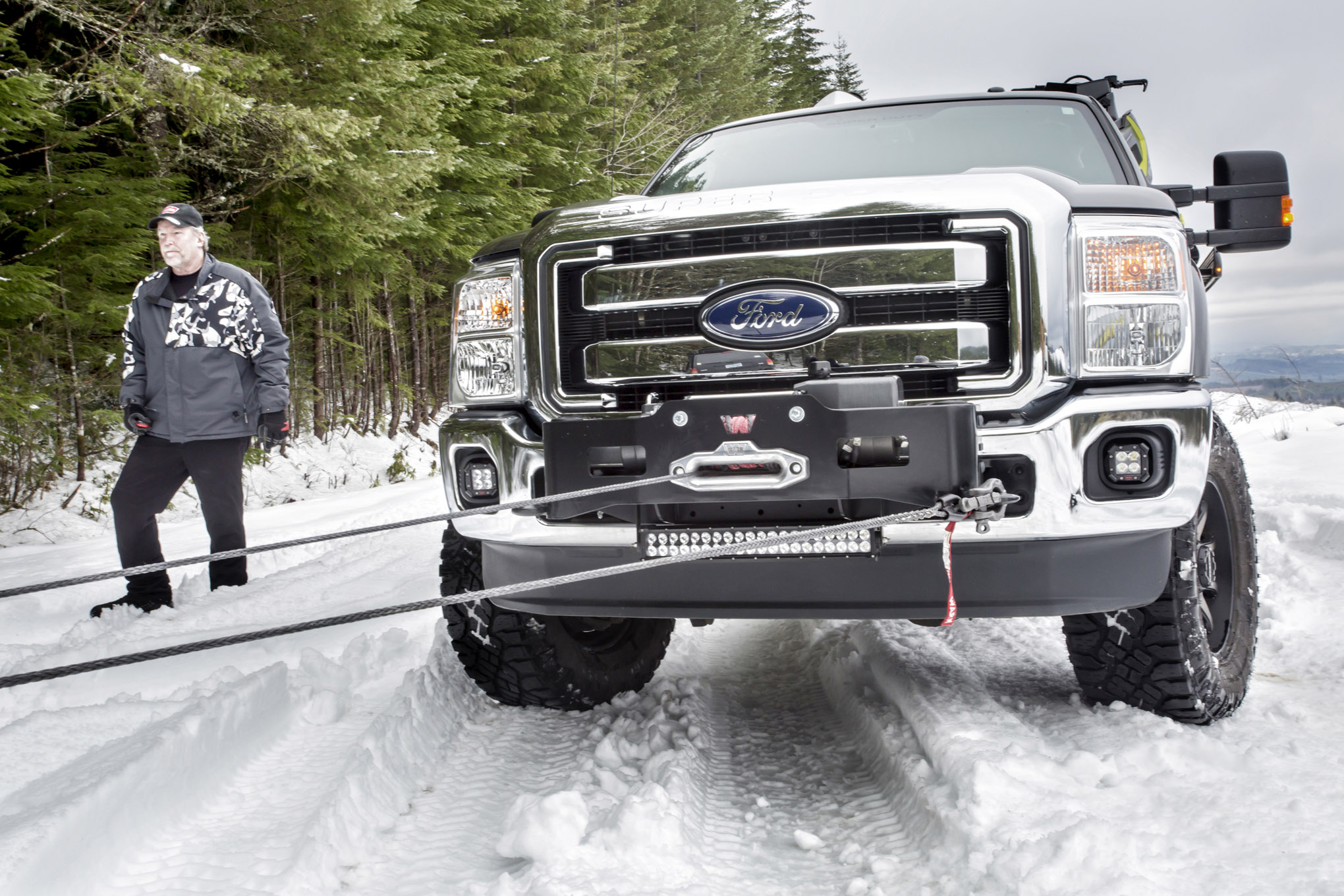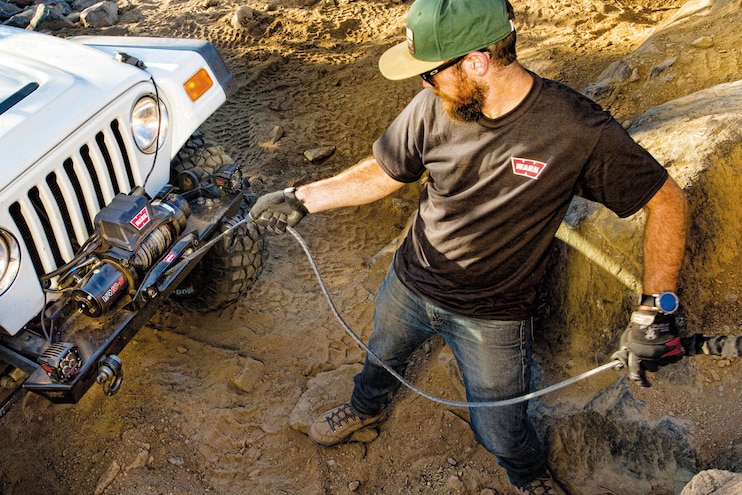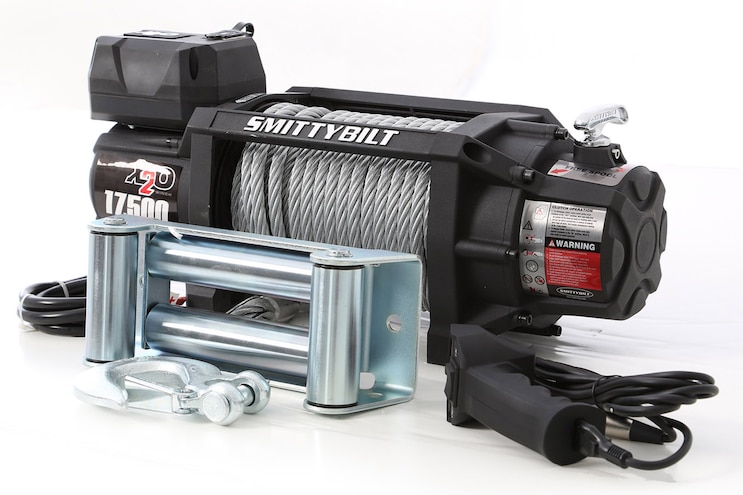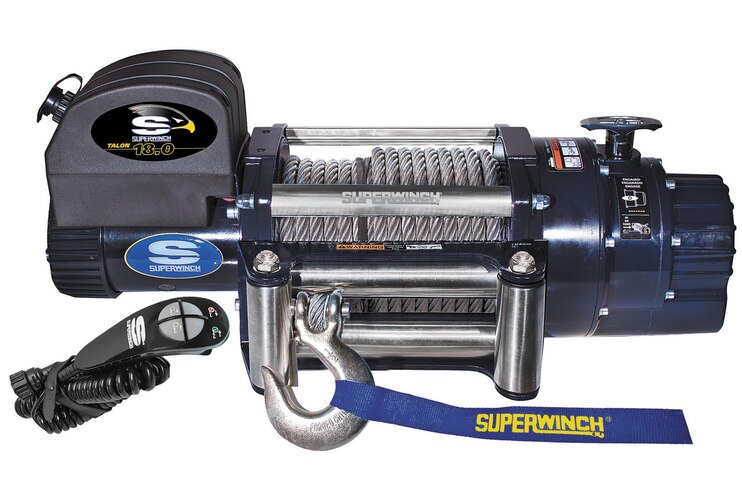The Only Remedy When Your Truck is Stuck: Winch Out

Slick, soft terrain. A misplaced tire. An error in driver judgement. Overestimating vehicle ability. The aforementioned—and other reasons—can cause a vehicle’s forward momentum to suddenly cease, making it necessary to grab the winch cable.
Whether for self-recovery or helping someone else get their immobilized truck moving again under its own power, having a strong winch to provide the muscle needed to get a heavy diesel pickup back on track is a wonderful feeling.
Winches are excellent insurance against a costly “being stuck” experience. If you are a business owner, time is money, and having winch-equipped trucks that work in adverse conditions can decrease downtime and wasted resources.
Likewise, if you are just an enthusiast who uses your four-wheel-drive diesel rig for recreation, time is also precious, and not having to spend hours digging yourself out of a hole or sitting on the tailgate waiting for help to arrive can easily justify having a good winch onboard.
 Photo 2/17 | Heavy-duty diesel trucks often come to the rescue of others, and, when that happens, having a winch that’s up to the task can save the day.
Photo 2/17 | Heavy-duty diesel trucks often come to the rescue of others, and, when that happens, having a winch that’s up to the task can save the day.
A winch can be a useful tool for a variety of other uses as well, from mending fences and cutting firewood to moving storm debris blocking a road or even pulling a vehicle or boat onto a trailer. Winches are also easily transferred from one vehicle to another, so when you get rid of a truck and replace it, you don’t have to reinvest in another winch. The biggest concern is deciding which winch will be right for the job.
Diesel owners who have been in situations where a winch was needed to save the day can attest that one can never have too much pulling power lending a helping hand. Selecting a winch is a lot like choosing a good tow vehicle: The more torque and horsepower available, the easier it is to tow a heavy trailer.
In most situations when a vehicle gets stuck, the driving tires dig down, creating a vertical shelf that prevents the tires from moving forward in the mud, sand, snow, or loose soil. In order for the truck to regain forward (or backward) momentum, the tires have to be pulled up and over that shelf. To do that, a winch has to have the muscle to lift/pull the full weight of the vehicle being extracted.
 Photo 3/17 | Having the ability to “self-recover” when a wrong turn or road conditions stop forward progress is the main reason why a winch is one of the first accessories added by heavy-duty truck owners.
Photo 3/17 | Having the ability to “self-recover” when a wrong turn or road conditions stop forward progress is the main reason why a winch is one of the first accessories added by heavy-duty truck owners. Photo 4/17 | Every vehicle equipped with a winch should carry an accessory kit that includes a tree-saver strap, choker chain, two shackles, a snatch block, winch strap, and leather gloves. Four-wheel-drive rigs that use heavy-duty winches should add a 3×6-foot tree-saver strap; 3×30-foot recovery strap; a 6-foot 5/16-inch GR100 choker chain; a second snatch block; and at least three 7/8-inch shackles to handle heavier pulls.
Photo 4/17 | Every vehicle equipped with a winch should carry an accessory kit that includes a tree-saver strap, choker chain, two shackles, a snatch block, winch strap, and leather gloves. Four-wheel-drive rigs that use heavy-duty winches should add a 3×6-foot tree-saver strap; 3×30-foot recovery strap; a 6-foot 5/16-inch GR100 choker chain; a second snatch block; and at least three 7/8-inch shackles to handle heavier pulls.
The general rule of thumb when choosing a winch for fullsize diesel pickups is to select one that has at least 1.2 times the pulling power of the truck’s gross vehicle weight rating (GVWR), with a better choice being a winch with 1.5 times more grunt than the GVWR (the base curb weight of the vehicle plus the amount the manufacturer says it can carry fully loaded—with optional accessories, cargo, and passengers). That number is usually listed on the vehicle identification tag attached to the driver’s doorjamb.
Let’s say you are equipping a ’19 ¾-ton truck with a GVWR of 10,000 pounds. A minimum winch capacity should be 12,000 pounds, with a better choice being one that’s rated at 15,000. Likewise, if you are installing a winch on a 1-ton dualie or heavier truck that has a GVWR between 12,000 and 14,000 pounds, a winch with a rating between 15,000 and 17,000 will do the job.
Most potential winch buyers immediately think electric when they begin shopping. Electric winches are excellent choices: They are easy to install, relatively inexpensive, and provide pulling power even if the engine isn’t running—at least for a short period of time.
 Photo 5/17 | The most critical part of an electric-winch system is the truck’s electrical system. Batteries and alternators need to be able to meet the demand when the winch load is applied. If they are not capable, even the best winch in the world is useless.
Photo 5/17 | The most critical part of an electric-winch system is the truck’s electrical system. Batteries and alternators need to be able to meet the demand when the winch load is applied. If they are not capable, even the best winch in the world is useless.
There’s the rub: Electric winches are wholly dependent on the vehicle’s electrical system to provide the power to pull. As a battery’s ability to provide juice goes down, so does winching power. Electric winches are designed for very short duration pulls; the electric motors and solenoids have short “duty cycles” and need time to cool down between winching sessions.
That’s where hydraulic winches come into play. A hydraulic winch doesn’t need to take a break. As long as the pump feeding its hydraulics is running, it’ll pull with all its might without fear of anything overheating, burning out, or draining batteries. They are the “Steady Eddie” of winching.
 Photo 6/17 | Hydraulic winches, like this 12,000-pound-capacity Mile Marker H-model, are available in a wide range of pulling power up to 18,000 pounds. The beauty of a hydraulic winch over its electric counterpart is the fact that it supplies full, continuous winching power without any battery drain.
Photo 6/17 | Hydraulic winches, like this 12,000-pound-capacity Mile Marker H-model, are available in a wide range of pulling power up to 18,000 pounds. The beauty of a hydraulic winch over its electric counterpart is the fact that it supplies full, continuous winching power without any battery drain.
The downsides to hydraulic winches: 1) they cost a considerable amount more than an electric winch of similar capacity; and 2) installation requires more work because a hydraulic pump is installed and hoses must be run. Some hydraulic winches operate off the truck’s power steering system, others have their own pump, and a few are driven off the power takeoff unit if the truck is so equipped. But, if you plan on doing some serious winching or winch on a regular basis, a hydraulic model is worth considering.
Electric or hydraulic, at some point there will come a time when that maximum pulling power is tested. The max-pull rating on every winch is measured on the innermost wrap of line around the drum.
That’s because the “first wrap” delivers the most leverage, and, consequently, the greatest mechanical advantage. Each time the winch line makes another layer, the overall gearing gets “taller” and pulling power is reduced.
The more layers on the drum, the less each succeeding outer layer’s load capacity reduces the leverage factor. Most heavy-duty winches’ effective pulling power is reduced by about 15 to 20 percent per layer depending on make/model. That is born out when you take a close look at the performance specifications of a winch.
For example, the Warn 16.5ti is rated at 16,500 pounds on the first layer, but only 12,600 pounds on the third wrap, and 10,800 on the fourth. So, the more cable that’s spooled off the drum, the more recovery power a winch delivers because the decreasing diameter of the spool of cable provides more leverage. (For safety’s sake, never winch with less than five turns of the cable/rope on the first layer!)
 Photo 7/17 | Sometimes a winching situation doesn’t afford or require a straight line pull, or the pull requires more muscle than the winch can provide on its own. That’s where a snatch block comes into play. A snatch block is used for changing the direction of the pull, and, if needed, to change the pull ratio, so the winch is actually doubling or tripling its rated pulling power. To “double” the effective pulling power, run the winch cable though a snatch block at the anchor and bring the hook back to the winching vehicle. To triple the effective pulling power, run the winch cable through a second snatch block attached to the winching vehicle, then back to a tree-saver strap/shackle at the primary anchor point—or one close by. (Illustration courtesy Warn Industries)
Photo 7/17 | Sometimes a winching situation doesn’t afford or require a straight line pull, or the pull requires more muscle than the winch can provide on its own. That’s where a snatch block comes into play. A snatch block is used for changing the direction of the pull, and, if needed, to change the pull ratio, so the winch is actually doubling or tripling its rated pulling power. To “double” the effective pulling power, run the winch cable though a snatch block at the anchor and bring the hook back to the winching vehicle. To triple the effective pulling power, run the winch cable through a second snatch block attached to the winching vehicle, then back to a tree-saver strap/shackle at the primary anchor point—or one close by. (Illustration courtesy Warn Industries)
Pulling power of electric winches is also dictated by how much juice is flowing from the truck’s batteries to the winch motor. Powering a winch places the biggest hit on the alternator and the biggest drain on batteries. Choosing too small a capacity winch actually makes electrical matters worse.
The higher horsepower electric motors in the heavy pullers, along with the mechanical advantages of their lower gearing, provide more winching power with less drain on a vehicle’s system than their smaller counterparts. That’s good news for diesel-truck owners, because it means a heavy-duty winch will have a longer life than its smaller brethren when subjected to hard pulls.
For example, a robust 15,000-pound-capacity Mile Marker SEC15 winch draws 290 amps pulling 9,000 pounds, and 420 amps when delivering its full 15,000 pounds of winching power. Warn’s 16.5ti draws 342 amps at 10,000 pounds and 507 amps at its full 16.5K. Meanwhile, a lower-rated winch, like Warn’s 9.5xp, draws 413 amps at 8,000 pounds and 482 amps at 9,500.
Understanding amp draw is important because most stock diesel alternators supply less than 250 amps, while dual-alternators feed the batteries around 400 to 450 amps. If the winch is drawing more amps than the alternator can supply, the batteries are being drained. As battery power weakens, so does winching power.
 Photo 8/17 | Being safe is the number one priority in any winching situation. Always wear gloves and proper clothing, and be aware of the dangers of the winching poses. (Photo courtesy Warn Industries)
Photo 8/17 | Being safe is the number one priority in any winching situation. Always wear gloves and proper clothing, and be aware of the dangers of the winching poses. (Photo courtesy Warn Industries)
There are dozens of winches on the market well-suited for use on heavy-duty diesel trucks and SUVs. We’ve compiled a sampling of some of the newest heavy hitters on today’s market to help narrow down one to grace the front of your truck. Combined with a heavy-duty winch bumper, any one of these pullers will be capable of getting a stuck rig moving again.
 Photo 9/17 | The Badland ZXR winch from Harbor Freight Tools has a rated capacity of 12,000 pounds behind a 6hp series-wound motor and 265:1 gear ratio. It includes 65 feet of 3/8-inch cable, roller fairlead, and mounting hardware. The entry-level winch retails for $399.99.
Photo 9/17 | The Badland ZXR winch from Harbor Freight Tools has a rated capacity of 12,000 pounds behind a 6hp series-wound motor and 265:1 gear ratio. It includes 65 feet of 3/8-inch cable, roller fairlead, and mounting hardware. The entry-level winch retails for $399.99. Photo 10/17 | Priced at $469.99, Engo USA’s SR12 comes with 85 feet of 3/8-inch cable spooled by a 6hp motor that pulls 12,000 pounds with just a 360-amp draw. The solenoid box can be relocated if need be, and the clutch engagement/disengagement can be clocked in 10 different locations for hidden mounts. Engo USA offers a 1-year electrical warranty and lifetime limited mechanical warranty to the original purchaser.
Photo 10/17 | Priced at $469.99, Engo USA’s SR12 comes with 85 feet of 3/8-inch cable spooled by a 6hp motor that pulls 12,000 pounds with just a 360-amp draw. The solenoid box can be relocated if need be, and the clutch engagement/disengagement can be clocked in 10 different locations for hidden mounts. Engo USA offers a 1-year electrical warranty and lifetime limited mechanical warranty to the original purchaser. Photo 11/17 | Kodiak Winches from Quality Gear utilize a 4.8hp series-wound motor and 295.75:1 gearing to get 12,000 pounds of pulling power. The Grizzly model, which retails for $463.95, features 100 feet of 3/8-inch cable, roller fairlead, and a Bear Essentials winch-accessory kit. The clutch handle is easily clockable to 12 different positions.
Photo 11/17 | Kodiak Winches from Quality Gear utilize a 4.8hp series-wound motor and 295.75:1 gearing to get 12,000 pounds of pulling power. The Grizzly model, which retails for $463.95, features 100 feet of 3/8-inch cable, roller fairlead, and a Bear Essentials winch-accessory kit. The clutch handle is easily clockable to 12 different positions. Photo 12/17 | Mile Marker’s SEC15 is said to be the lightest 15,000-pound-capcaity winch in the industry, weighing just 63 pounds with 78 feet of synthetic rope. The sealed and submersible SEC15 uses a 6.8hp series-wound motor into 296:1 planetary gearing to get the power, drawing 420 amps at full pull. A steel-cable version is available for $799.99; the synthetic-rope model is priced at $1,099.99. Each unit is protected by a two-year warranty.
Photo 12/17 | Mile Marker’s SEC15 is said to be the lightest 15,000-pound-capcaity winch in the industry, weighing just 63 pounds with 78 feet of synthetic rope. The sealed and submersible SEC15 uses a 6.8hp series-wound motor into 296:1 planetary gearing to get the power, drawing 420 amps at full pull. A steel-cable version is available for $799.99; the synthetic-rope model is priced at $1,099.99. Each unit is protected by a two-year warranty. Photo 13/17 | With a limited-lifetime warranty on mechanical parts and two years on electrical components, the $599 Pierce Arrow PS12000 is a standout in self-recovery winches. Fast line speed, a 5.5hp series-wound motor, and heavy-duty build quality get the job done. The unit includes 85 feet of 3/8-inch cable and roller fairlead.
Photo 13/17 | With a limited-lifetime warranty on mechanical parts and two years on electrical components, the $599 Pierce Arrow PS12000 is a standout in self-recovery winches. Fast line speed, a 5.5hp series-wound motor, and heavy-duty build quality get the job done. The unit includes 85 feet of 3/8-inch cable and roller fairlead. Photo 14/17 | Serious off-road competitors love fast hydraulic winches, and Red Winches’ Terrier rocks with 16,500 pounds of military-tested capacity. Starting at $952, built in the United Kingdom, and fitted on a wide range of military vehicles around the world, this high-grade, precision-engineered, high-performance yet compact winch is capable of operating in the most demanding of situations.
Photo 14/17 | Serious off-road competitors love fast hydraulic winches, and Red Winches’ Terrier rocks with 16,500 pounds of military-tested capacity. Starting at $952, built in the United Kingdom, and fitted on a wide range of military vehicles around the world, this high-grade, precision-engineered, high-performance yet compact winch is capable of operating in the most demanding of situations. Photo 15/17 | Waterproof, wireless, and with a monstrous 17,500 pounds of pull, the biggest of Smittybilt’s $629.99 Gen2 X2O winches features a series-wound amphibious 6.6hp motor that is completely sealed, as well as a three-stage planetary gear system. A state-of-the-art, 500-amp solenoid can be mounted in two different locations depending on the application, and the controller can be wired directly to the winch or unplugged for trouble-free, wireless operation.
Photo 15/17 | Waterproof, wireless, and with a monstrous 17,500 pounds of pull, the biggest of Smittybilt’s $629.99 Gen2 X2O winches features a series-wound amphibious 6.6hp motor that is completely sealed, as well as a three-stage planetary gear system. A state-of-the-art, 500-amp solenoid can be mounted in two different locations depending on the application, and the controller can be wired directly to the winch or unplugged for trouble-free, wireless operation. Photo 16/17 | Superwinch’s large-frame Talon 18 boasts an incredible line speed for a winch of its pulling capacity, perfect for those who need to work fast. The maintenance-free design, with a 6hp motor and 346:1 gearing, is truly military grade. The winch’s control box can be relocated to accommodate tight spaces on hidden-winch bumpers, and the gearbox can be reclocked to ensure the clutch knob remains accessible. The Talon 18 retails for $1,543.77 and carries a limited-lifetime mechanical/3-year electrical warranty.
Photo 16/17 | Superwinch’s large-frame Talon 18 boasts an incredible line speed for a winch of its pulling capacity, perfect for those who need to work fast. The maintenance-free design, with a 6hp motor and 346:1 gearing, is truly military grade. The winch’s control box can be relocated to accommodate tight spaces on hidden-winch bumpers, and the gearbox can be reclocked to ensure the clutch knob remains accessible. The Talon 18 retails for $1,543.77 and carries a limited-lifetime mechanical/3-year electrical warranty. Photo 17/17 | With a massive 16,500-pound capacity, the large-frame 16.5ti-s ($2,767.99) is not only the most powerful winch in Warn Industries’ arsenal, it’s also available with 80 feet of 3/8-inch lightweight, easy-to-handle Spydura® Pro synthetic rope. This $2,767.99 winch also features a cone brake and thermometric indicator that provides operator feedback during the winching process to prevent overheating during extreme use. A limited-lifetime warranty is also available.
Photo 17/17 | With a massive 16,500-pound capacity, the large-frame 16.5ti-s ($2,767.99) is not only the most powerful winch in Warn Industries’ arsenal, it’s also available with 80 feet of 3/8-inch lightweight, easy-to-handle Spydura® Pro synthetic rope. This $2,767.99 winch also features a cone brake and thermometric indicator that provides operator feedback during the winching process to prevent overheating during extreme use. A limited-lifetime warranty is also available.
Winch Wiring
“The biggest concerns I’ve come across within the realms of winching are all attributed to electrical power,” says Chris Claeys, Pierce Winch Manager. “You’ve got a massive amp draw when winching, so it’s critical you have the [electrical] power there to support it. You have to make sure the proper-gauge wire is used for the winch and battery ground cables. Then you have to make sure the power supply during winching is enough to keep everything working properly. You can easily shorten the life of a winch by not wiring it properly from the beginning and not keeping the truck’s battery(s) charged before and during winching.”
10 Winch Safety Tips
-Wear leather gloves when handling the winch cable.
-Keep hands away from the fairlead and cable drum.
-Make sure the hook, shackles, and clevis are fastened securely before winching.
-Keep bystanders at least 50 feet away and to the side of the winching procedures.
-Always place a heavy bag, coat, or floor mat over the cable at the midway point to act as a damper should the cable come loose under load.
-Never stand beside a winch under load.
-Never attach a winch cable to a tow ball, OEM bumper, spring shackles, or steering components.
-Never begin winching with less than four cable wraps on the drum.
-Winch in short bursts to keep the winch motor/solenoids from overheating.
-Inspect the winch cable prior to winching to ensure there are no frays or kinks.
